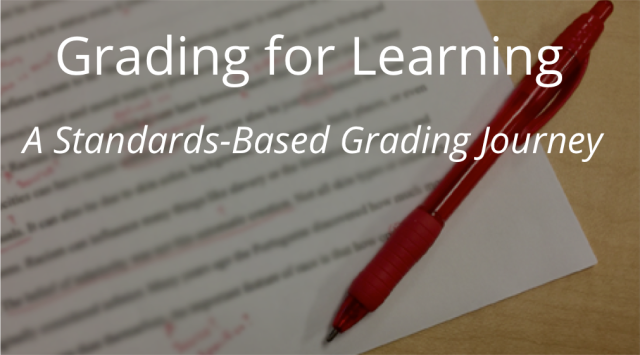
If indeed learning is the business of our business, do all of our systems within our schools truly promote and reflect that?
In our case within the Byron Public Schools, not entirely. One glaring misaligned “learning” practice identified in our schools was in the area of grading and reporting. Like most schools, we had been using the traditional grading practice based on points and percentages. The grades students were receiving were not always reflective what they knew or understood. This question led us on a district wide quest over the last several years towards practices that closer measured what our students were learning in relation to what we wanted them to learn.
This process is formally known as Standards Based Grading (SBG) or Grading for Learning. It encompasses the belief that there is a better, more appropriate, more accurate, more transparent way to convey what is being learned throughout the year to our students and parents. This notion hinges on some fundamental learning premises:
- One is that standards, curriculum and instruction require tight alignment. Our standards should drive what is being taught in our classrooms rather than a text book or content that one arbitrarily finds interesting.
- Secondly, Grading for Learning requires assessments that are tied directly to the standard and learning objective and promote transparent feedback to students and parents. Knowing whether our students understand and have attained proficiency on the intended standard is important in gauging the learning that is happening.
- Lastly, Grading for Learning requires a fundamental shift away from a punitive points and percentage based system, towards a grade book philosophy where learning is truly recognized as knowledge acquisition without incentives and penalties.
In Byron, this shift in thinking began with an emphasis on Professional Learning Communities. Over half of our teaching staff have received formal training around this process answering the four essential questions. As a district we deconstructed this PLC process focusing on question one, “What is it that our students need to know”. This happened to coincide with a transition in our evaluation system. We moved to the Marzano professional growth model and district-wide emphasized one element (Learning Goals and Scales). This dove tailed with question one in the PLC model. Each grade and department spent a year getting to know their standards in a more intentional manner and began determining what standards were deemed essential using clear criteria:
- Endurance – information that extends beyond one grade or course; concepts and skills needed in life
- Leverage – interdisciplinary connections that have crossover application
- Readiness – prerequisite concepts and skills students need to be ready for the next grade level
This process was essential for us to gain alignment in what we were teaching and move away from a coverage philosophy. The following year our district emphasized assessment learning for our staff. We learned about the purpose of each of the assessment’s we had in place and provided time for staff to create both formative and summative scales connected to our recently identified Essential Learning Outcomes.
Again, the time we took for staff to create and implement their scale work was essential for us to gauge where our gaps were and how to enhance transparent feedback to both students and parents.
During the course of these two years, a report card committee representative of departments and grade levels had been meeting to discuss this SBG implementation. We met each month to report out on progress and challenges along with answering questions to important learning around the grading philosophy we wanted to move towards. These crucial questions are noted below and were essential to gaining buy in and creating traction towards a successful SBG implementation. Another critical component to this process was the communication that we had with our parents and stakeholders. We hosted several parent informational sessions, provided resources for parents online and shared information with parents through monthly communications.
This fall we kicked off our Standards Based Grading with our parents and students. While it has not been without its challenges, I would say it has been well worth the hard work, time and effort.
Change is messy and never easy. Change with a purpose though can be beneficial. When that change is for the betterment of our kids and their learning it cannot be underestimated.
While every process is different and unique I like to think the one we went through was right for us. While it’s not complete and very well may never be, one thing is for certain: Byron Schools are much closer to measuring more accurately what a student knows and has learned than we ever have done before.
Essential/Crucial Questions
- What is the purpose of the report card?
- How often will the report cards be completed and sent home? (quarterly, trimester)
- Will a specific report card be developed for each grade level or will a more general one be used across grade levels?
- How many reporting standards will be included for each subject area or course?
- What specific reporting standards will be included at each grade level or in each course?
- Will standards (proficiency) be set for each grade level or each marking/reporting period?
- What specific process and progress standards will be reported?
- How many levels of performance will be reported for each standard?
- How will the levels be labeled?
- Will teachers’ comments be included and encouraged?
- How will information be arranged on the report card?
- What are parents expected to do with the information?
- What are students expected to do with the information?
- What policies need to accompany the new reporting procedures?
- When should input of parents and/or students be sought?
Article by:
Abe Rodemeyer, principal
Byron Intermediate
Byron Public Schools
Twitter: @aberodemeyer
Abe Rodemeyer, principal
Byron Intermediate
Byron Public Schools
Twitter: @aberodemeyer
No comments:
Post a Comment